Printer-friendly PDF version →
SHRP2 C19 Close-Out Report
| This report summarizes progress the Federal Highway Administration (FHWA) and American Association of State Highway Officials (AASHTO) made during the Second Strategic Highway Research Program’s (SHRP2) in FY 2013 through 2016 on: |
| Product: |
Expediting Project Delivery (C19) – Helps transportation agencies deliver projects with greater efficiency and speed by encouraging the use of innovative approaches and early coordination with resource agencies, stakeholders, and the public. The product identifies 16 common constraints to efficient project delivery and recommends 24 strategies, organized into six themes, to expedite project delivery. |
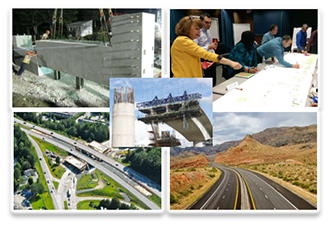
Photos:
VTrans, Volpe, Maricopa Association of
Governments, VTrans, Volpe
|
| Goal: |
Integrate expediting project delivery principles into routine transportation planning, and resource and regulatory agency business practices. |
| Budget: |
$2.6 million budget (SAFETEA-LU
funds) for fiscal years 2013-16. |
Second Strategic Highway Research Program (SHRP2)
SHRP2 relied on the partnership between FHWA, AASHTO, and the Transportation Research Board (TRB). TRB completed the research, and now FHWA and AASHTO jointly implemented the resulting SHRP2 Solutions that helped the transportation community enhance productivity, boost efficiency, increase safety, and improve the reliability of the Nation’s highway system. SHRP2 was funded by Congress.
The program launched more than 100 research projects to address the most pressing needs of the Nation’s highway system. The projects advanced innovative methods in the areas of Safety, Renewal, Reliability, and Capacity. Expediting Project Delivery, or C19, is one SHRP2 Solution listed under the Capacity focus area.
Expediting Project Delivery Connections to One Federal Decision
The need to expedite project delivery—delivering projects quickly and efficiently—and develop tools to assist in this effort is increasing in national focus. The 24 strategies identified through SHRP2 are increasing in use.
Executive Order 13807 (August 15, 2017) is an excellent example of the national focus to expedite project delivery and the need to apply strategies to this end. In short, the Executive Order (E.O.) established the Discipline and Accountability in the Environmental Review and Permitting Process for Infrastructure Projects and does the following:
- Required Federal agencies to process environmental reviews and authorization decisions for “major infrastructure projects” as One Federal Decision (OFD).
- Set a government-wide goal of two years to complete the required environmental reviews and authorization decisions for major infrastructure projects.
FHWA recommends project sponsors apply concepts that align with Planning and Environment Linkages (PEL) strategies and Expediting Project Delivery Strategy 14 to meet the two-year timeframe for major infrastructure projects. FHWA worked with the U.S. Coast Guard, the U.S. Army Corps of Engineers, the U.S. Environmental Protection Agency, the U.S. Fish and Wildlife Service, and the National Marine Fisheries Services to develop a Written Agreement, committing to work together to achieve the E.O. goals. The agencies collaboratively developed a process chart aligning
NEPA
and permitting processes, both with and without using PEL.
Other Expediting Project Delivery strategies being applied to support the E.O. are: Strategy 4: Coordinated and Responsive Agency Involvement, Strategy 8: Expedited Internal Review and Decision Making, Strategy 9: Facilitation to Align Expectations Up Front, and Strategy 18: Real-Time Collaborative Interagency Reviews.
Status of SHRP2 Implementation Plan Activities: Expediting Project Delivery
This table reports on the performance for the Expediting Project Delivery SHRP2 Solution. It identifies the SHRP2 Implementation strategies goals and accomplishments from the SHRP2 funding investment. The total budget for Expediting Project Delivery was $2.6 million, with 54%, or $1.4 million, allocated to the C19 portion of the Implementation Assistance Program (IAP).
| Implementation Strategies |
Strategy Description |
Items Produced |
| Organizational Awareness |
Information and resources that elevate the visibility of C19 among target audiences to increase awareness of its benefits. |
- 4 webinars delivered hosted by AASHTO.
- C19 Brochure created.
- 6 IAP case studies developed.
- Funded Transportation liaison research, Planning and Environmental Linkages Work, Tribal programmatic agreement collection, and a Section 106 peer exchange, connecting C19 to other FHWA programs.
|
| Provide Training & Technical Assistance (TA) |
Education that helps integrate the strategies in C19 into new visions for success among leadership executives. Educational materials and opportunities for practitioners to learn how to implement the C19 strategies. Training on the integration of transportation and environmental data. |
- 1 C19 event at TRB’s 2016 summer meeting.
- 2 presentations given at conferences (AASHTO Standing Committee on Environment and Standing Committee on Bridges and Structures).
- 6 assessment workshops given.
- Implementation Handbook developed.
|
| Collaboration, relationship building, and knowledge sharing |
Funding, tools, and resources that facilitate cooperative interaction between transportation and resource and regulatory agencies to support implementation of C19. |
- 2 peer exchanges (Section 106, NEPA Assignment).
|
| Formal implementation of C19 strategies through guidelines, model agreements, policies, and processes |
Templates, examples, and guidance for various documents and processes that support implementation. |
- Expediting Project Delivery Self-Assessment Workbook developed.
|
| Brand and market C19 |
Information and resources that promote awareness and associates C19 with a consistent name and set of benefits. |
- The C19 website provides a consistent brand for the product.
- Developed 6 case studies on IAP recipients to communicate successful implementation.
- Electronic Starter Kit developed.
- Currently marketing strategies & Tools.
|
| Implementation Assistance Program |
Provide funding to 12 State
DOTs
and
MPOs
to implement the Expediting Project Delivery Strategies. |
- 12 States successfully implemented one or more Expediting Project Delivery Strategies.
- Final reports and/or deliverables that explain how the Strategies were implemented.
|
Examples of SHRP2 Expediting Project Delivery in Practice
Expediting Project Delivery has been successfully applied at a variety of scales. The following two examples highlight the improved processes and coordination realized through implementing the Expediting Project Delivery Strategies.
Maricopa Association of Governments (MAG)
Multi-Jurisdictional Collaboration to Improve Project Delivery |
Timeline: 2 years (2014-2016)
Budget: $240,000 |
|
Overview
The Maricopa Association of Governments applied two Expediting Project Delivery strategies to improve coordination and data sharing, and ultimately, project planning and delivery, in the Intermountain West region.
With a $240,000 investment, MAG worked to conduct stakeholder outreach to partner agencies in the region to identify needs and gaps related to transportation and data resources, develop a common GIS platform to better support planning efforts, and develop a risk register to identify risks to transportation projects in the Intermountain West area to serve as a proof of concept.
|
Key Results
- Increased understanding of data resources in the Intermountain West Region.
- Increased communication among partner agencies.
- Improved relationships among partner agencies.
- Transferrable data collection process.
- Significant Intermountain West information developed.
|
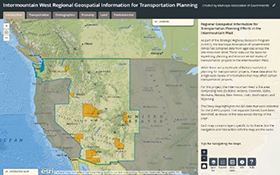
Intermountain West Story Map (MAG)
|
Vermont Agency of Transportation
Accelerated Bridge Program Process Improvements |
Timeline: 4 years (2013-2017)
Budget: $206,000 |
|
Overview
The Vermont Agency of Transportation (VTrans) applied four Expediting Project Delivery strategies to develop process improvements for their Accelerated Bridge Program (ABP).
With a $206,000 investment, VTrans implemented the following initiatives under this effort: created one-page project fact sheets for the public on each project; created a Public Involvement Guide (PIG); co-located some of its Structures and Hydraulics engineers to foster an environment of heightened communication and collaboration, among others.
|
Key Results
- 36-month reduction in project development timelines, from 60 months to 24 months.
- 35 percent savings in preliminary engineering costs for the bridges that have been replaced as part of the ABP.
- Improved public outreach through new communication mechanisms.
- Institutionalization of Expediting Project Delivery concepts to other parts of VTrans.
|
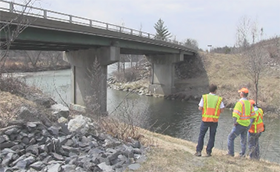
VTrans Bridge Program staff at a project site. (VTrans)
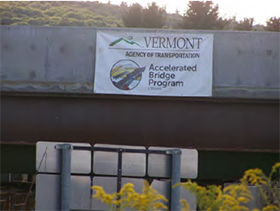
VTrans ABP promotional banner, Hartford Lateral Side (VTrans)
|
Key Findings and Benefits
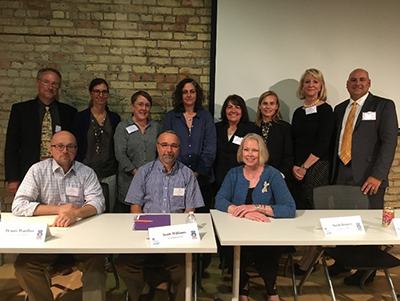
Panelists at the Section 106 Peer Exchange, July 2017 (Volpe)
The C19 IAP recipients were most successful in implementing the expedited internal review and decision making strategy.
IAP recipients implemented this strategy in various ways, from specific software to process improvements to developing new procedures and accompanying documentation. Some of the recipients did not identify this strategy as one they planned to implement, but ultimately achieved this strategy through their work. The IAP projects allowed the recipients to break down internal silos and come together to discuss ways to improve communication and increase efficiencies.
Benefits:
- Built internal and external partner relationships was the most commonly cited benefit. This increased communication led to coalition building, and ultimately increased trust between partners. The C19 IAP project gave the recipients an opportunity to interact with, and solicit feedback and ideas from other divisions within their organization and to communicate more frequently and openly with partners that they might not have otherwise engaged.
- Conducted a holistic look not often possible to do given time and budget constraints. C19 IAP funding made it possible to review the entire project delivery process and address problems that would not have been addressed otherwise.
- FHWA-led assessment workshop helped to focus the scope of the project as noted by the workshop, and created actionable items to move the project forward. Additional benefits include improved data sharing internally and with partners.
Lessons Learned
Management and leadership support is integral to the success of Expediting Project Delivery within transportation agencies. Additionally, it is important to engage various staff levels when implementing changes to ensure their viewpoints are considered. Agencies also learned that involving partners early helps to ensure their priorities are also considered. Developing a method to coordinate with external and internal partners ensures that communication happens during process changes. Agencies saw the value in formalizing processes by creating manuals or standard operating procedures (SOPs) to ensure continuity and prevent loss of institutional knowledge when there is turnover.
For More Information
Contact
David T. Williams
FHWA Office of Project Development and Environmental Review (HEPE)
(202) 366-4074
David.Williams@dot.gov
Resources
Related Initiatives

